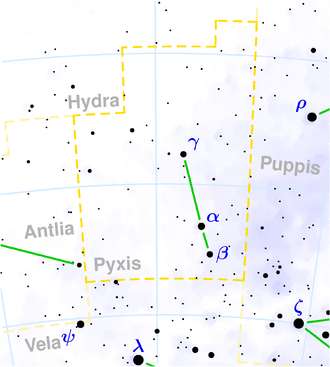NGC 2772
| Galaxy NGC 2772 |
|
|---|---|
![NGC 2772 with LEDA 25653 [1]](https://upload.wikimedia.org/wikipedia/commons/thumb/a/a3/NGC_2772_DSS.jpg/300px-NGC_2772_DSS.jpg)
|
|
| NGC 2772 with LEDA 25653 | |
| AladinLite | |
| Constellation | Ship compass |
|
Position equinox : J2000.0 , epoch : J2000.0 |
|
| Right ascension | 09 h 07 m 41.9 s |
| declination | -23 ° 37 ′ 17 ″ |
| Appearance | |
| Morphological type | Sb: / pec / sp / HII |
| Brightness (visual) | 13.4 mag |
| Brightness (B-band) | 14.2 mag |
| Angular expansion | 1.5 ′ × 0.5 ′ |
| Position angle | 170 ° |
| Surface brightness | 12.9 mag / arcmin² |
| Physical data | |
| Redshift | 0.011428 ± 0.000030 |
| Radial velocity | 3426 ± 9 km / s |
|
Stroke distance v rad / H 0 |
(144 ± 10) · 10 6 ly (44.0 ± 3.1) Mpc |
| history | |
| discovery | John Herschel |
| Discovery date | January 23, 1835 |
| Catalog names | |
| NGC 2772 • PGC 25654 • ESO 497-014 • MCG -04-22-002 • IRAS 09054-2325 • 2MASX J09074186-2337172 • SGC 090528-2325.1 • NVSS J090741-233718 | |
NGC 2772 is a spiral galaxy with extensive star formation regions of the Hubble type Sb in the constellation Ship Compass in the southern sky . It is an estimated 217 million light years from the Milky Way and about 115,000 light years in diameter. Together with PGC 25653 , it forms an interactive galaxy pair .
The object was discovered by John Herschel on January 23, 1835 .
